How to Perform a Windows Server Change Password in Minutes [Fast]
Ever been locked out of a server because you forgot your password, or worse, realized it is time to update credentials but are not sure where to start? If you manage or support a Windows Server, handling password changes is part of the job, but it can be surprisingly tricky if you do not know the right steps. Whether tightening security or helping a teammate regain access, knowing how to perform a Windows Server change password correctly can save you time, stress, and even downtime. This guide will walk you through the process clearly and simply.

In this article:
Method 1. Change Password for Windows Server by Resetting
If you are locked out of your Windows Server or need to reset a password, imyPass Windows Password Reset is a safe and easy solution. You do not need to be a tech expert - just follow the simple steps, and you will be back in control in no time. The tool lets you create a reset disk operating on a CD, DVD, or USB flash drive to pick what works best for your setup. It also has an easy-to-use interface that walks you through each part of the process.
imyPass supports all versions of Windows, including Windows Server 2008, 2012, 2016, and newer. Best of all, the reset process is safe, so your files and system stay protected. If you are looking for a quick and reliable way to change the Administrator password on Windows Server 2012, then the imyPass tutorial below will surely lead you to success.
Tick the button to download the latest version of the imyPass Windows password reset tool. Once downloaded, follow the configuration instructions to install it on your computer.
Pick the option that works best for you. The tool lets you create a password reset disk using a Burn CD/DVD or a Burn USB flash drive. Use a blank CD, DVD, or USB drive before you insert it into your computer - either in the disc tray or USB port. When the burning process is done, disconnect and hit OK to continue.
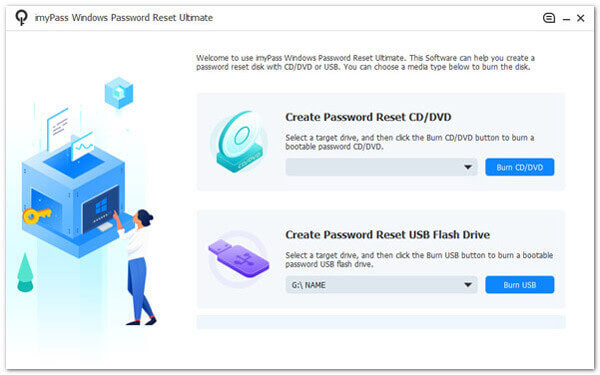
Insert the newly created reset disk into the locked computer. Restart the device and press F12 or ESC to open the Boot Menu. If you are using another Windows model, you can search for the button to press to access the Boot menu. In the Boot Menu, go to the Boot tab, choose the inserted disk or drive, press Enter, then hit F10 to save changes and exit.
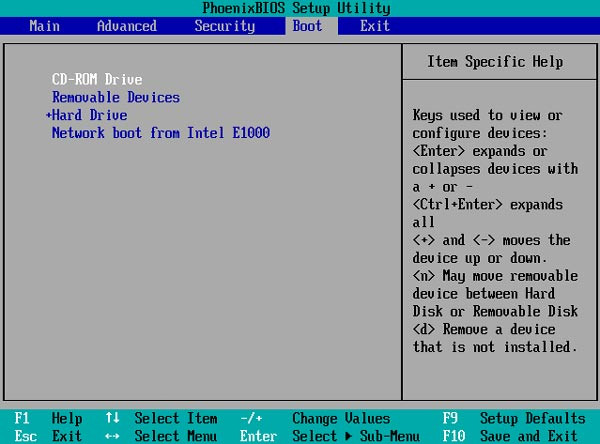
Choose the Windows version you want to unlock. Select the account, click Reset Password on the next screen, then hit OK to confirm.
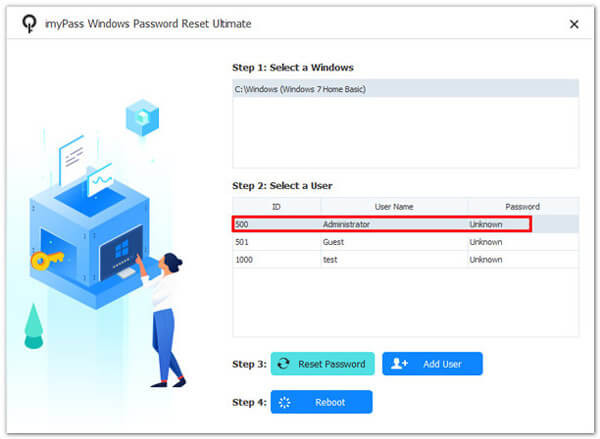
Once the reset is complete, you can remove the disk or drive. Click Reboot to restart your computer. From there, you can log in or adjust any other settings.
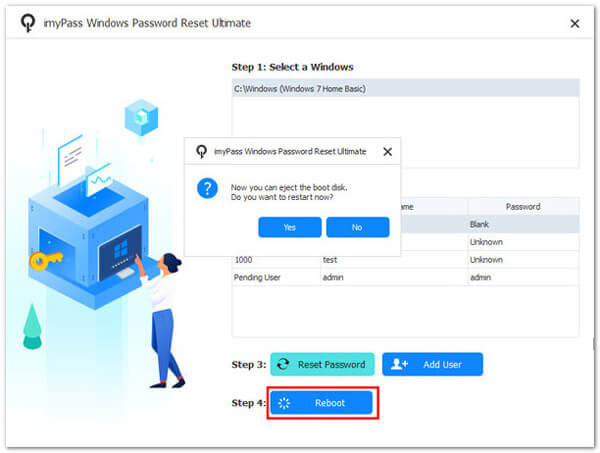
This app gives you full control when resetting your Windows password, offering a smoother, faster, and more user-friendly experience compared to PassFab 4WinKey and many other alternatives on the market. With its high success rate, easy-to-follow steps, and reliable performance across different Windows versions, it stands out as a top choice for beginners and advanced users needing a quick solution.
Method 2. Windows Server Change Password Using Shortcut Key
If you are logged into Windows Server 2019 and need to update your administrator password, using a shortcut key combination is a quick and straightforward method. This approach is especially useful when you have direct access to the server. A shortcut key combines keys pressed simultaneously to perform a specific action more efficiently. In this case, we will use a shortcut to access the password change screen.
Follow these steps to change the Administrator password on Windows Server 2019:
Press Ctrl + Alt + Delete on your keyboard simultaneously. It will bring up a screen with several options. From the list of options, click on Change a password.
A new window will appear. Enter your current password in the field, then type your new password in the next two fields to confirm it.
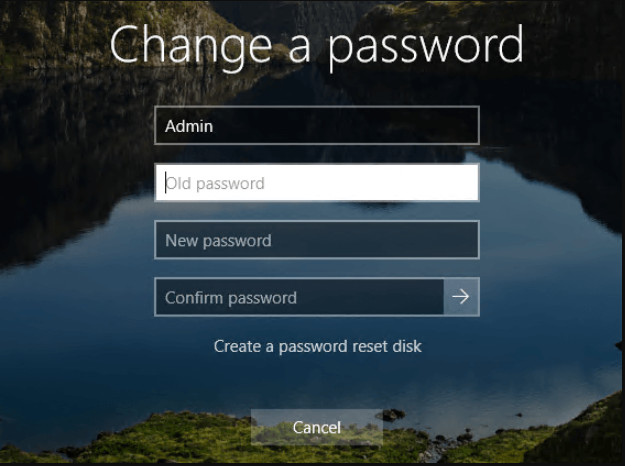
To apply the new password, tick the arrow button or press Enter. Once the password has been successfully changed, a validation message will appear.
After changing the password, you will return to the previous screen. You can now use your new password for forthcoming logins.
Note: If you are connected to the server via Remote Desktop Protocol or RDP, the standard Ctrl + Alt + Delete shortcut may not work as expected. In such cases, use Ctrl + Alt + End instead to access the same menu that allows you to change or reset the password on Windows 7.
Method 3. Windows Server Change Password Using Notepad
Notepad is a primary text editor that comes built-in with every version of Windows. While it is usually used to write or edit plain text, you can also run simple scripts. This method will show you how to use Notepad to create a quick script that helps reset or change a password on your Windows Server. This is a useful option if you want to change the domain password on Windows Server 2012 from an account that still has admin access.
Open Notepad on your Windows Server. You can see it by clicking the Start menu, typing Notepad, and pressing Enter. In the Notepad window, type the following command and replace the new password with the password you want to set.
net user administrator newpassword
Click File > Save As, save the file with a .bat extension, and make sure to change the Save as type option to All Files before clicking Save.. For example: resetpassword.bat
Right-click the .bat file you just created, then select Run as administrator. It will execute the command and reset the Administrator password.
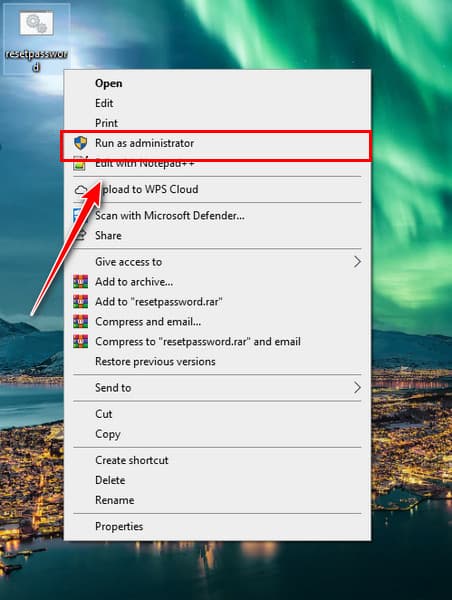
Once complete, you can log in using the new password or help another user access their domain account, which is especially useful when changing passwords for Windows Server 2012.
Note: This method only works if you are logged in with administrator rights. If you are locked out of the server, use Method 1 instead.
Conclusion
Access to servers is extremely important in maintaining the security of your system. You can always reset your password with a tool, a shortcut key, or a simple script in order to keep you in control of your Windows Server.
If you ever need to change the administrator password on Windows Server 2019, these solutions offer a quick and safe way to do it, no matter your experience level. Just take several steps, and you will get access back in a few minutes. Update your passwords and the readiness of tools, and keep the server protected.
Hot Solutions
-
Windows Password
-
Windows Tips
-
Fix Windows
-
Password Tips

